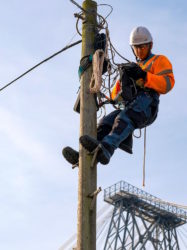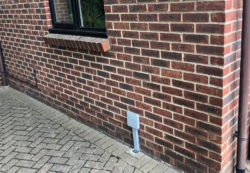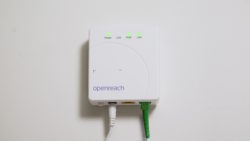Find out how BT’s full fibre broadband is installed. Plus get free set-up & a £50 reward card on BT’s full fibre deals from £28.99 per month.
 In the UK, BT is currently offering £0 installation when you upgrade to their full fibre (FTTP) broadband. In addition, they’ve reduced the price of their Full Fibre 100 service to just £28.99 per month. This gives you the UK’s most reliable broadband technology with average download speeds of 150Mbps.
In the UK, BT is currently offering £0 installation when you upgrade to their full fibre (FTTP) broadband. In addition, they’ve reduced the price of their Full Fibre 100 service to just £28.99 per month. This gives you the UK’s most reliable broadband technology with average download speeds of 150Mbps.
In this article, we’ll look at BT’s full fibre broadband including the benefits of upgrading to it and how it’s installed in your home. We’ll also look at the full fibre deals from BT, including their latest offer on Full Fibre 100.
Why BT Full Fibre?
 Full fibre (also known as fibre-to-the-premises, or FTTP for short) is the UK’s latest and most advanced fibre broadband technology. Unlike normal fibre broadband, it uses a fibre optic cable all the way into your home. This gives you all of the following benefits:
Full fibre (also known as fibre-to-the-premises, or FTTP for short) is the UK’s latest and most advanced fibre broadband technology. Unlike normal fibre broadband, it uses a fibre optic cable all the way into your home. This gives you all of the following benefits:
- You’ll get faster download speeds on full fibre. With full fibre (FTTP) broadband, you’ll get faster download speeds than you would on regular fibre broadband. For instance, BT’s Full Fibre 100 plan gives you an average download speed of 150Mbps. This is more than twice the speed of their Fibre 2 plan which has an average download speed of 67Mbps.
- You can use more devices at the same time on full fibre. With full fibre, there’s capacity for more devices to be using your broadband connection at the same time. That means you can stream, game, work and play on more devices at the same time. You can also keep all of your smart home devices connected to the internet.
- There are fewer slowdowns and less disruption with full fibre. Traditional fibre broadband services use copper for the final part of the connection into your home. This can sometimes be susceptible to noise and interference. In contrast, full fibre broadband isn’t susceptible to these problems.
- Full fibre is better for the environment. The copper cables used for regular fibre broadband make use of an increasing rare and precious metal. Furthermore, these copper cables use a lot of electricity to keep them powered and to carry data on the line. In contrast, full fibre is much more energy efficient. According to BT, the energy saved by upgrading the country to full fibre technology will be enough to power, light, heat and cool 175,000 homes.
In the past, full fibre plans have often been more expensive than regular fibre broadband plans. Alternatively, they’ve come with additional fees (e.g. for setting up the service). This makes it a great time to upgrade your home to the latest full fibre technology.
How is Full Fibre Installed?
 As full fibre (FTTP) broadband makes use of a fibre optic connection all the way into your home, you’ll need to book an engineer visit to install it, unless you’ve already had full fibre installed in the past.
As full fibre (FTTP) broadband makes use of a fibre optic connection all the way into your home, you’ll need to book an engineer visit to install it, unless you’ve already had full fibre installed in the past.
At present, BT’s full fibre broadband service is available in about 10 million UK homes. This means it isn’t yet available at all UK addresses, though BT is working to roll this out to 25 million homes by the end of 2026. To see if it’s currently available where you live, enter your postcode on BT’s website.
If you’re lucky enough to live in an area with access to full fibre (FTTP) technology, you can place an order online and an engineer will visit your home to install the full fibre service. This consists of several key steps:
- A fibre optic cable will have already been laid to a telephone pole or underground duct near your home. If you’re able to place an order for full fibre (FTTP) broadband, this means a fibre optic cable will have already been laid to a telephone pole or an underground duct near your home. That means the engineer only needs to do the final part which is to connect your home up to the existing full fibre network.
 The engineer will put in a new fibre optic cable going to the outside of your home. Usually, this new fibre optic cable will follow the path of your existing copper phone line. This means, for instance, they’ll run a fibre optic cable through the existing underground duct if you have one for your copper phone line. Alternatively, they’ll connect you to the full fibre network with an overhead cable that follows the path of your existing phone line.
The engineer will put in a new fibre optic cable going to the outside of your home. Usually, this new fibre optic cable will follow the path of your existing copper phone line. This means, for instance, they’ll run a fibre optic cable through the existing underground duct if you have one for your copper phone line. Alternatively, they’ll connect you to the full fibre network with an overhead cable that follows the path of your existing phone line.- A small junction box will be installed on the outside of your home. This is where the fibre optic cable will end on the outside of your property. Also known as the Customer Service Point (CSP), it’s a small box that measures about 15cm x 13cm in size.
 A full fibre modem will be installed inside your home. This is a wall-mounted modem (also known as the ONT). It’s a bit like the master socket you’d find on an analogue phone line, but it’s a little bit larger (about 13cm x 11cm in size). As it needs to deal with digital signals over a fibre optic connection, it needs to be plugged in to a power socket at the wall to work. The full fibre modem is also referred to as a Optical Network Termination point (or ONT for short).
A full fibre modem will be installed inside your home. This is a wall-mounted modem (also known as the ONT). It’s a bit like the master socket you’d find on an analogue phone line, but it’s a little bit larger (about 13cm x 11cm in size). As it needs to deal with digital signals over a fibre optic connection, it needs to be plugged in to a power socket at the wall to work. The full fibre modem is also referred to as a Optical Network Termination point (or ONT for short).- A small amount of drilling is required to connect the outside junction box to the inside modem. To connect the external junction box (the CSP) to the internal modem (the ONT), a small hole will be need to be drilled through the wall. This hole will be about 12mm wide. A fibre optic cable will be fed through this hole, connecting to the two boxes and bringing the fibre optic connection into your home.
 Your Smart Hub router can then be plugged in. To complete the installation, the engineer will then connect your new BT Smart Hub router to the modem. That’ll provide you with a wi-fi connection that you can use from other devices.
Your Smart Hub router can then be plugged in. To complete the installation, the engineer will then connect your new BT Smart Hub router to the modem. That’ll provide you with a wi-fi connection that you can use from other devices.
In total, it takes about three hours to get your home connected to BT’s full fibre network. However, the good news is that it’s a once-in-a-lifetime upgrade. That’s because all of the fibre optic cables are future-proof.
If you upgrade to a faster plan in the future, or if you switch to another full fibre provider that’s using the Openreach network, you’ll be able to continue using the fibre optic cable that’s already been put in. Because of that, there’s no need for another engineer visit to set it all up again.
BT Full Fibre Deals
The following table shows BT’s latest full fibre deals, with a £50 reward card included when you sign up through this link.
| Service | Download Speed | Monthly Cost (will rise each April by £4) |
|
|---|---|---|---|
 Full Fibre 150 Offer ends 25th Sep | 150Mbps average download | £28.99 per month No upfront fee £150 reward card 24 month contract | See deal |
 Full Fibre 300 Offer ends 25th Sep | 300Mbps average download | £30.99 per month No upfront fee £150 reward card 24 month contract | See deal |
 Full Fibre 500 Offer ends 25th Sep | 500Mbps average download | £31.99 per month No upfront fee £150 reward card 24 month contract | See deal |
 Full Fibre 900 Offer ends 25th Sep | 900Mbps average download | £35.99 per month No upfront fee £150 reward card 24 month contract | See deal |
In addition, you can add the BT TV Entertainment or Sport plan to your BT Full Fibre service. The following table shows the latest full fibre and TV deals:
| Service | Broadband & TV | Monthly Cost (will rise each April by £6) |
|
|---|---|---|---|
 Full Fibre 150 + Entertainment
| 150Mbps average download
| £29.99 per month No upfront fee with £50 reward card 24 month contract | See deal |
 Full Fibre 150 + Sport
| 150Mbps average download
| £51.99 per month No upfront fee £150 reward card 24 month contract | See deal |
More Information
For more information about BT’s full fibre service, please see BT’s official website. There’s also more information on the Openreach website that details how full fibre broadband (FTTP) gets installed in your home.
Dave said:
Prices are La La. As an existing customer you don’t pay more than a new customer…for the same package you’re already on that is…i.e. for me to move to from FTTC to FTTP 150Mb/s is not £29.99, it’s £64.72
Nathan Jones said:
I live in a property where the current duct for my copper cable has been enveloped by an extension. The master socket can be accessed internally but its external location is inaccessible.
It is the same duct as my neighbours property but they split under my porch.
Will openreach likely just route it another way as the master socket location is also not in the ideal location. The way the house layout works it’d be better for the router to be located nearer the rear of the property.
Alternatively, I sign up for Gigaclear or similar and they would put it a new (shallow) connection.
Roy said:
Can they use the same path inside house for the fiber wire.
Ken replied:
Hi Roy,
Thanks for your comment. Yes, the new fibre optic cable will normally just follow the path of your old copper phone line.
Hope this helps,
Ken